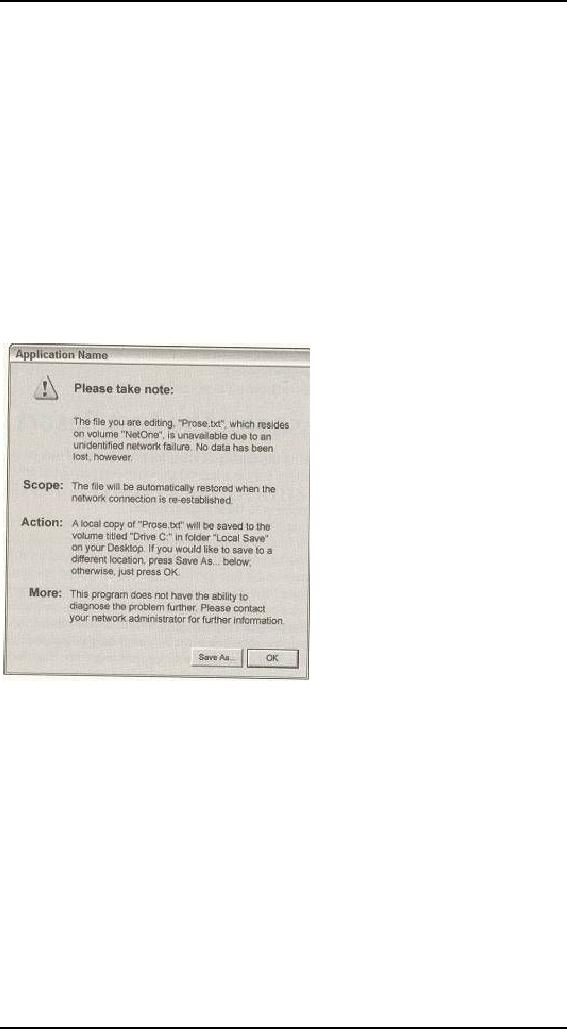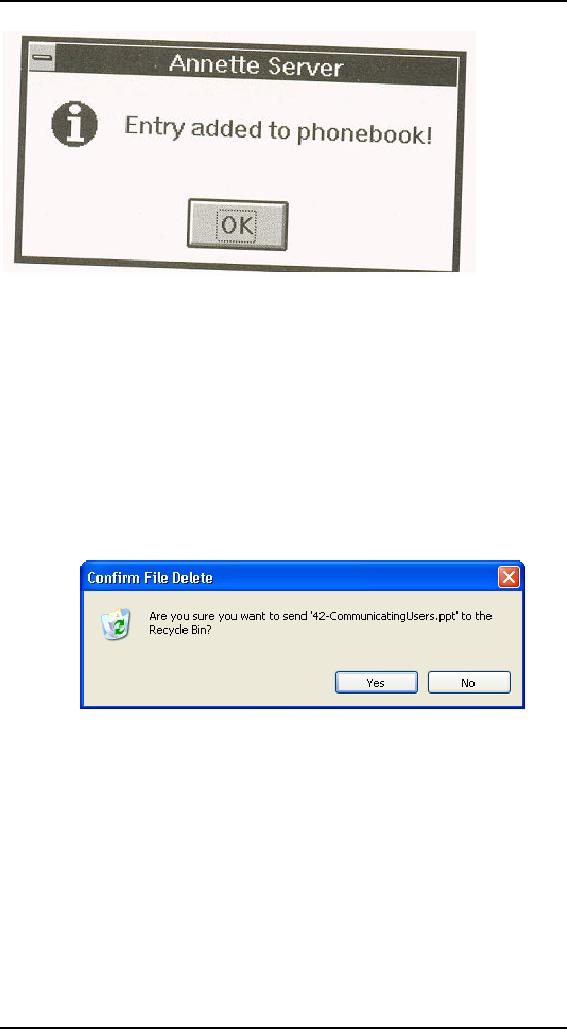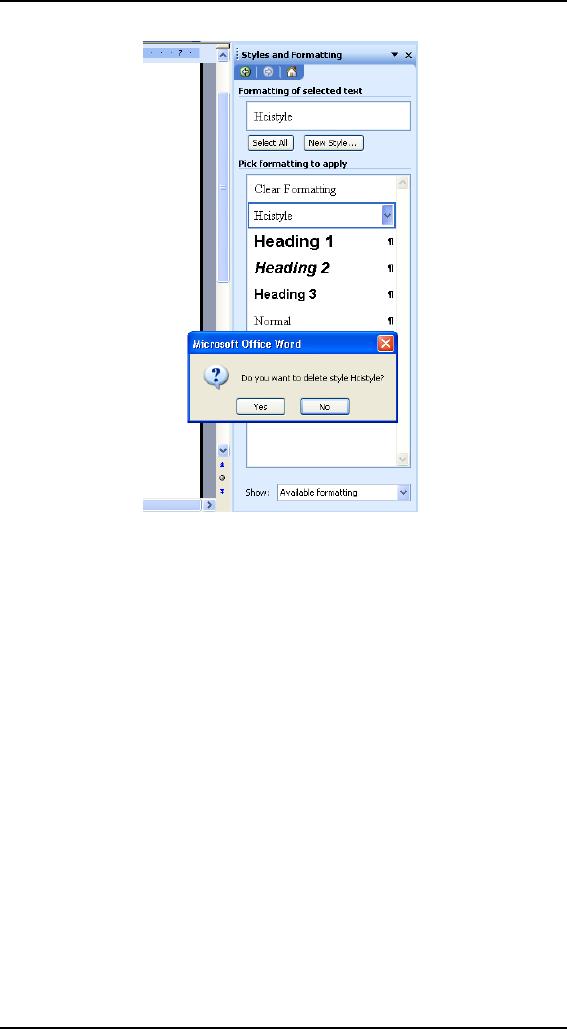 |

Human
Computer Interaction
(CS408)
VU
Lecture
42
Lecture
42. Communicating
Users
Learning
Goals
As the
aim of this lecture is to
introduce you the study of
Human Computer
Interaction,
so that after studying this
you will be able to:
Discuss
how to eliminate error
messages
Learn
how to eliminate notifiers
and confirmatory
messages
Eliminating
Errors
42.1
Bulletin
dialog boxes are used
for error messages,
notifiers, and confirmations,
three
of the
most abused components of modern GUI
design. With proper design,
these
dialogs
can all but be eliminated.
In this lecture, we'll
explore how and
why.
Errors Are
Abused
There is
probably no more abused
idiom in the GUI world than
the error dialog.
The
proposal
that a program doesn't have
the right -- even the
duty -- to reject the
user's
input is
so heretical that many
practitioners dismiss it summarily. Yet,
if we examine
this
assertion rationally and from
the user's -- rather than
the programmer's --
point
of view,
it is not only possible, but
quite reasonable.
Users
never want error messages.
Users want to avoid the
consequences of making
errors,
which is very different from
saying that they want
error messages. It's
like
saying
that people want to abstain
from skiing when what
they really want to do
is
avoid
breaking their legs.
Usability guru Donald Norman
(1989) points out that
users
frequently
blame themselves for errors in product
design. Just because you
aren't
getting
complaints from your users
doesn't mean that they are
happy getting error
messages.
Why We Have So Many Error
Messages
The
first computers were undersized,
underpowered, and expensive,
and didn't lend
themselves
easily to software sensitivity.
The operators of these machines were
white-
lab-coated
scientists who were sympathetic to
the needs of the CPU
and weren't
offended
when handed an error
message. They knew how
hard the computer
was
working.
They didn't mind getting a
core dump, a bomb, an "Abort,
Retry, Fail?" or
the
infamous "FU" message (File
Unavailable). This is how
the tradition of
software
treating
people like CPUs began.
Ever since the early days of
computing,
programmers
have accepted that the
proper way for software to
interact with humans
402

Human
Computer Interaction
(CS408)
VU
was to
demand input and to complain
when the human failed to
achieve the same
perfection
level as the CPU.
Examples
of this approach exist
wherever software demands
that the user do things
its
way
instead of the software
adapting to the needs of the
human. Nowhere is it
more
prevalent,
though, than in the
omnipresence of error
messages.
What's Wrong with Error
Messages
Error
messages, as blocking modal
bulletins must stop the proceedings
with a modal
dialog
box. Most user interface
designers -- being programmers -- imagine
that their
error
message boxes are alerting
the user to serious problems.
This is a widespread
misconception.
Most error message boxes
are informing the user of
the inability of the
program
to work flexibly. Most error
message boxes seem to the
user like an
admission
of real stupidity on the
program's part. In other
words, to most users,
error
message
boxes are seen not
just as the program stopping
the proceedings but, in
clear
violation
of the axiom: Don't stop the
proceedings with idiocy. We
can significantly
improve
the quality of our
interfaces by eliminating error
message boxes.
People hate error
messages
Humans
have emotions and feelings:
Computers don't. When one
chunk of code
rejects
the input of another, the
sending code doesn't care; it doesn't scowl,
get hurt, or
seek
counseling. Humans, on the
other hand, get angry
when they are flatly told
they
are
idiots.
When
users see an error message
box, it is as if another person has
told them that
they
are
stupid. Users hate this. Despite
the inevitable user
reaction, most programmers
just
shrug their shoulders and
put error message boxes in
anyway. They don't
know
how
else to create reliable
software.
Many
programmers and user
interface designers labor under
the misconception
that
people
either like or need to be told
when they are wrong. This
assumption is false in
several
ways. The assumption that
people like to know when
they are wrong
ignores
human
nature. Many people become
very upset when they are
informed of their
mistakes
and would rather not
know that they did
something wrong. Many
people
don't
like to hear that they are
wrong from anybody but
themselves. Others are only
willing
to hear it from a spouse or close
friend. Very few wish to
hear about it from a
machine.
You may call it denial,
but it is true, and users
will blame the
messenger
before
they blame themselves.
The
assumption that users need to
know when they are wrong is
similarly false. How
important
is it for you to know that
you requested an invalid type
size? Most
programs
can make a reasonable
substitution.
We
consider it very impolite to
tell people when they
have committed some
social
faux
pas. Telling someone they
have a bit of lettuce
sticking to their teeth or
that their
fly is
open is equally embarrassing for
both parties. Sensitive
people look for ways
to
bring
the problem to the attention
of the victim without
letting others notice.
Yet
programmers
assume that a big, bold
box in the middle of the
screen that stops all
the
action
and emits a bold "beep" is
the appropriate way to
behave.
Whose mistake is it,
anyway?
Conventional
wisdom says that error
messages tell the user
when he has made some
mistake.
Actually, most error bulletins
report to the user when
the program gets
403

Human
Computer Interaction
(CS408)
VU
confused.
Users make far fewer
substantive mistakes than imagined.
Typical "errors"
consist of
the user inadvertently
entering an out-of-bounds number, or
entering a
space
where the computer doesn't
allow it. When the
user enters something
unintelligible
by the computer's standards, whose fault is
it? Is it the user's fault
for
not
knowing how to use the
program properly, or is it the
fault of the program for
not
making
the choices and effects
clearer?
Information
that is entered in an unfamiliar
sequence is usually considered an
error by
software,
but people don't have
this difficulty with
unfamiliar sequences.
Humans
know
how to wait, to bide their
time until the story is
complete. Software
usually
jumps to
the erroneous conclusion
that out-of-sequence input
means wrong input
and
issues
the evil error message
box.
When,
for example, the user
creates an invoice for an
invalid customer number, most
programs
reject the entry. They stop
the proceedings with the
idiocy that the
user
must make
the customer number valid
right now. Alternatively,
the program could
accept
the transaction with the
expectation that a valid customer
number will
eventually
be entered. It could, for
example, make a special
notation to itself
indicating
what it lacks. The program
then watches to make sure
the user enters the
necessary
information to make that customer
number valid before the
end of the
session,
or even the end of the
month book closing. This is
the way most humans
work.
They don't usually enter
"bad" codes. Rather, they
enter codes in a
sequence
that
the software isn't prepared
to accept.
If the
human forgets to fully
explain things to the
computer, it can after
some
reasonable
delay, provide more
insistent signals to the
user. At day's or week's end
the
program
can move irreconcilable
transactions into a suspense
account. The program
doesn't
have to bring the
proceedings to a halt with an
error message. After all,
the
program
will remember the transactions so they
can be tracked down and
fixed. This
is the
way it worked in manual
systems, so why can't computerized
systems do at least
this
much? Why stop the entire
process just because
something is missing? As long
as
the
user remains well informed
throughout that some accounts
still need tidying,
there
shouldn't
be a problem. The trick is to
inform without stopping the
proceedings.
If the
program were a human
assistant and it staged a
sit-down strike in the
middle of
the
accounting department because we
handed it an incomplete form,
we'd be pretty
upset. If we
were the bosses, we'd
consider finding a replacement
for this anal-
retentive,
petty, sanctimonious clerk.
Just take the form,
we'd say, and figure out
the
missing
information. The experts
have used Rolodex programs
that demand you
enter
an area
code with a phone number
even though the person's
address has already
been
entered.
It doesn't take a lot of intelligence to
make a reasonable guess at the
area
code. If
you enter a new name
with an address in Menlo
Park, the program
can
reliably
assume that their area code
is 650 by looking at the
other 25 people in
your
database
who also live in Menlo
Park and have 650 as
their area code. Sure, if
you
enter a
new address for, say, Boise,
Idaho, the program might be
stumped. But how
tough is
it to access a directory on the
Web, or even keep a list of
the 1,000 biggest
cities in
America along with their
area codes?
Programmers
may now protest: "The
program might be wrong. It
can't be sure. Some
cities
have more than one
area code. It can't make
that assumption without
approval of
the
user!" Not so.
If we asked a
human assistant to enter a
client's phone contact
information into our
Rolodex,
and neglected to mention the
area code, he would accept it
anyway,
expecting
that the area code would
arrive before its absence
was critical.
Alternatively,
he could look the address up
in a directory. Let's say
that the client is in
404

Human
Computer Interaction
(CS408)
VU
Los
Angeles so the directory is
ambiguous: The area code
could be either 213 or
310.
If our
human assistant rushed into
the office in a panic
shouting "Stop what
you're
doing!
This client's area code is
ambiguous!" we'd be sorely
tempted to fire him
and
hire
somebody with a
greater-than-room-temperature IQ. Why
should software be
any
different?
A human might write 213/310?
into the area code field in
this case. The
next
time
we call
that client, we'll have to
determine which area code is
correct, but in the
meantime,
life can go on.
Again,
squeals of protest: "But the
area code field is only big
enough for three
digits!
I can't
fit 213/310? into it!"
Gee, that's too bad. You
mean that rendering the
user
interface
of your program in terms of the
underlying implementation model --
a
rigidly
fixed field width -- forces
you to reject natural human
behavior in favor of
obnoxious,
computer-like inflexibility supplemented
with demeaning error
messages?
Not to
put too fine a point on
this, but error message
boxes come from a failure of
the
program
to behave reasonably, not
from any failure of the
user.
This
example illustrates another
important observation about
user interface design.
It
is not
only skin deep. Problems
that aren't solved in the
design are pushed through
the
system
until they fall into
the lap of the user.
There are a variety of ways
to handle the
exceptional
situations that arise in interaction
with software -- and a
creative designer
or
programmer can probably
think of a half-dozen or so off
the top of her head --
but
most
programmers just don't try.
They are compromised by
their schedule and
their
preferences, so
they tend to envision the
world in the terms of perfect
CPU behavior
rather
than in the terms of imperfect
human behavior.
Error messages don't
work
There is
a final irony to error
messages: They don't prevent
the user from
making
errors.
We imagine that the user is
staying out of trouble
because our trusty
error
messages
keep them straight, but
this is a delusion. What
error messages really do
is
prevent
the program from getting
into trouble. In most software,
the error messages
stand
like sentries where the
program is most sensitive, not
where the user is
most
vulnerable,
setting into concrete the
idea that the program is
more important than
the
user. Users
get into plenty of trouble
with our software, regardless of
the quantity or
quality
of the error messages in it.
All an error message can do is
keep me from
entering
letters in a numeric field -- it
does nothing to protect me
from entering the
wrong
numbers -- which is a much more
difficult design
task.
Eliminating Error
Messages
We can't
eliminate error messages by
simply discarding the code
that shows the
actual
error
message dialog box and
letting the program crash if
a problem arises.
Instead,
we need to
rewrite the programs so they
are no longer susceptible to
the problem. We
must
replace the error-message with a
kinder, gentler, more robust
software that
prevents
error conditions from
arising, rather than having
the program merely
complain
when things aren't going
precisely the way it wants.
Like vaccinating it
against a
disease, we make the program
immune to the problem, and
then we can toss
the
message that reports it. To
eliminate the error message,
we must first eliminate
the
possibility
of the user making the
error. Instead of assuming error
messages are
normal,
we need to think of them as abnormal
solutions to rare problems -- as
surgery
instead of aspirin. We need to treat
them as an idiom of last
resort.
405

Human
Computer Interaction
(CS408)
VU
Every
good programmer knows that
if module A hands invalid data to module
B,
module B
should clearly and
immediately reject the input
with a suitable error
indicator.
Not doing this would be a
great failure in the design
of the interface
between
the modules. But human
users are not modules of
code. Not only should
software
not reject the input
with an
error
message, but the software
designer must also reevaluate
the entire concept of
what
"invalid data" is. When it
comes from a human, the
software must assume
that
the
input is correct, simply
because the human is more
important than the
code.
Instead
of software rejecting input, it must
work harder to understand
and reconcile
confusing
input. The program may
understand the state of
things inside the
computer,
but
only the user understands
the state of things in the
real world. Ultimately, the
real
world is
more relevant and important
than what the computer
thinks.
Making errors
impossible
Making it
impossible for the user to
make errors is the best
way to eliminate
error
messages.
By using bounded gizmos for
all data entry, users are
prevented from ever
being
able to enter bad numbers.
Instead of forcing a user to
key in his selection,
present
him with a list of possible
selections from which to choose. Instead
of making
the
user type in a state code,
for example, let him
choose from a list of valid
state
codes or
even from a picture of a
map. In other words, make it
impossible for the
user
to enter
a bad state.
Another
excellent way to eliminate
error messages is to make
the program smart
enough
that it no longer needs to
make unnecessary demands. Many
error messages
say
things like "Invalid input.
User must type xxxx." Why
can't the program, if
it
knows
what the user must type,
just enter xxxx by itself
and save the user
the tongue-
lashing?
Instead of demanding that
the user find a file on a
disk, introducing the
chance
that the user will select
the wrong file, have
the program remember which
files
it has
accessed in the past and
allow a selection from that
list. Another example
is
designing
a system that gets the date
from the internal clock
instead of asking for
input
from the user.
Undoubtedly,
all these solutions will
cause more work for
programmers. However, it
is the
programmer's job to satisfy
the user and not
vice versa. If the
programmer
thinks of
the user as just another
input device, it is easy to
forget the proper
pecking
order in
the world of software
design.
Users of computers
aren't sympathetic to the
difficulties faced by programmers.
They
don't
see the technical rationale
behind an error message box.
All they see is the
unwillingness
of the program to deal with
things in a human
way.
One of
the problems with error
messages is that they are
usually post facto reports
of
failure.
They say, "Bad things just
happened, and all you
can do is acknowledge
the
catastrophe."
Such reports are not
helpful. And these dialog
boxes always come
with
an OK
button, requiring the user
to be an accessory to the crime.
These error message
boxes
are reminiscent of the scene
in old war movies where an
ill-fated soldier
steps
on a
landmine while advancing
across the rice paddy. He
and his buddies clearly
hear
the
click of the mine's
triggering mechanism and the
realization comes over
the
soldier
that although he's safe
now, as soon as he removes his foot
from the mine, it
will
explode, taking some large
and useful part of his
body with it. Users get
this
feeling
when they see most error
message boxes, and they
wish they were
thousands
of miles
away, back in the real
world.
406

Human
Computer Interaction
(CS408)
VU
Positive
feedback
42.2
One of
the reasons why software is
so hard to learn is that it so
rarely gives positive
feedback.
People learn better from
positive feedback than they
do from negative
feedback.
People want to use their
software correctly and
effectively, and they
are
motivated
to learn how to make the
software work for them.
They don't need to be
slapped
on the wrist when they
fail. They do need to be rewarded, or at
least
acknowledged,
when they succeed. They will
feel better about themselves if
they get
approval,
and that good feeling will
be reflected back to the
product.
Advocates
of negative feedback can
cite numerous examples of
its effectiveness in
guiding
people's behavior. This
evidence is true, but almost
universally, the context
of
effective
punitive feedback is getting
people to refrain from doing
things they want to
do but
shouldn't: Things like not
driving over 55 mph, not
cheating on their
spouses,
and
not fudging their income
taxes. But when it comes to
helping people do what
they
want to
do, positive feedback is
best. Imagine a hired ski
instructor who yells at
you,
or a restaurant host
who loudly announces to other
patrons that your credit
card was
rejected.
Keep in
mind that we are talking
about the drawbacks of
negative feedback from
a
computer.
Negative feedback by another person,
although unpleasant, can be
justified
in
certain circumstances. One can
say that the drill sergeant
is at least training you in
how to
save your life in combat,
and the imperious professor
is at least preparing you
for
the vicissitudes of the real
world. But to be given
negative feedback by
software
-- any
software -- is an insult. The
drill sergeant and professor
are at least human
and
have bona fide experience
and merit. But to be told by
software that you
have
failed is
humiliating and degrading. Users,
quite justifiably, hate to be humiliated
and
degraded.
There is nothing that takes
place inside a computer that
is so important that
it can
justify humiliating or degrading a
human user. We only resort
to negative
feedback
out of habit.
Improving
Error Messages: The Last
Resort
Now we
will discuss some methods of improving
the quality of error message
boxes,
if indeed
we are stuck using them. Use
these recommendations only as a
last resort,
when
you run out of other
options.
A
well-formed error message
box should conform to these
requirements:
Be
polite
Be
illuminating
Be
helpful
Never
forget that an error message
box is the program reporting
on its failure to do
its
job,
and it is interrupting the
user to do this. The error
message box must be
unfailingly
polite. It must never even
hint that the user
caused this problem,
because
that is
simply not true from
the user's perspective. The
customer is always right.
The
user may indeed have
entered some goofy data,
but the program is in no
position
to argue
and blame. It should do its
best to deliver to the user
what he asked for, no
matter
how silly. Above all,
the program must not, when
the user finally discovers
his
silliness,
say, in effect, "Well, you
did something really stupid,
and now you
can't
recover.
Too bad." It is the
program's responsibility to protect
the user even when
he
takes
inappropriate action. This
may seem draconian, but it
certainly isn't the
user's
responsibility
to protect the computer from
taking inappropriate
action.
407

Human
Computer Interaction
(CS408)
VU
The
error message box must
illuminate the problem for
the user. This means
that it
must give
him the kind of information
he needs to make an appropriate
determination
to solve
the program's problem. It
needs to make clear the
scope of the problem,
what
the
alternatives are, what the
program will do as a default, and
what information was
lost, if
any. The program should
treat this as a confession,
telling the user
everything.
It is
wrong, however, for the
program to just dump the
problem on the user's lap
and
wipe
its hands of the matter. It
should directly offer to
implement at least one
suggested
solution right there on the
error message box. It should
offer buttons that
will take
care of the problem in
various ways. If a printer is
missing, the message
box
should
offer options for deferring
the printout or selecting
another printer. If
the
database
is hopelessly trashed and useless, it
should offer to rebuild it to a
working
state,
including telling the user
how long that process will
take and what side
effects it
will
cause.
Figure
shows an example of a reasonable error
message. Notice that it is
polite,
illuminating,
and helpful. It doesn't even
hint that the user's
behavior is anything
but
impeccable.
Notifying and
Confirming
42.3
Now, we
discuss alert dialogs (also
known as notifiers) and
confirmation dialogs, as
well as
the structure of these
interactions, the underlying assumptions
about them, and
how
they, too, can be eliminated
in most cases. ?
Alerts and
Confirmations
42.4
Like
error dialogs, alerts and
confirmations stop the proceedings
with idiocy, but
they
do not
report malfunctions. An alert
notifies the user of the
program's action, whereas
a
confirmation also gives the
user the authority to
override that action. These
dialogs
pop up
like weeds in most programs
and should, much like
error dialogs, be
eliminated
in favor of more useful
idioms.
408

Human
Computer Interaction
(CS408)
VU
Alerts: Announcing the
obvious
When a
program exercises authority that it
feels uncomfortable with, it takes
steps to
inform
the user of its actions.
This is called an alert.
Alerts violate the axiom:
A
dialog
box is another room; you
should have a good reason to
go. Even if an alert
is
justified
(it seldom is), why go
into another room to do it?
If the program took
some
indefensible
action, it should confess to it in
the same place where
the action occurred
and
not in a separate dialog
box.
Conceptually,
a program should either have
the courage of its convictions or it
should
not
take action without the
user's direct guidance. If
the program, for example,
saves
the
user's file to disk
automatically, it should have
the confidence to know that
it is
doing
the right thing. It should
provide a means for the
user to find out what
the
program
did, but it doesn't have to stop
the proceedings with idiocy
to do so. If the
program
really isn't sure that it
should save the file, it
shouldn't save the file,
but
should
leave that operation up to
the user.
Conversely,
if the user directs the
program to do something -- dragging a
file to the
trash can.
for example -- it doesn't need to stop
the proceedings with idiocy
to
announce
that the user just
dragged a file to the trashcan.
The program should
ensure
that
there is adequate visual feedback
regarding the action; and if
the user has
actually
made the
gesture in error, the program
should silently offer him a
robust Undo facility
so he can
backtrack.
The
rationale for alerts is that
they inform the user.
This is a desirable objective,
but
not at
the expense of smooth interaction
flow.
Alerts
are so numerous because they
are so easy to create. Most languages
offer some
form of
message box facility in a
single line of code. Conversely,
building an
animated
status display into the face
of a program might require a
thousand or more
lines of
code. Programmers cannot be expected to
make the right choice in
this
situation.
They have a conflict of
interest, so designer: must be sure to
specify
precisely
where information is reported on
the surface of an application The
designers
must then
follow up to be sure that
the design wasn't
compromised for the sake
of
rapid
coding. Imagine if the
contractor on
a
building site decided
unilaterally not to add a
bathroom because it was just
too much
trouble
to deal with the plumbing.
There would be
consequences.
Software
needs to keep the user
informed of its actions. It
should have visual
indicators
built into its main
screen to make such status
information available to
the
user,
should he desire it. Launching an
alert to announce an unrequested action
is bad
enough.
Putting up an alert to announce a
requested action is pathological.
Software
needs to be flexible and
forgiving, but it doesn't need to be
fawning and
obsequious.
The dialog box shown in
Figure below is a classic
example of an alert
that
should be put out of our
misery. It announces that it added
the entry to our
phone
book.
This occurs immediately
after we told it to add the
entry to our phone
book,
which
happened milliseconds after we
physically added the entry
to what appears to
be our
phone book. It stops the
proceedings to announce the
obvious.
409

Human
Computer Interaction
(CS408)
VU
It's as
though the program wants
approval for how hard it
worked: "See, dear,
I've
cleaned
your room for you.
Don't you love me?" If a
person interacted with us
like
this,
we'd suggest that they
seek counseling.
Confirmations
S
When a
program does not feel
confident about its actions,
it often asks the user
for
approval
with a dialog box. This is
called a confirmation, like
the one shown in
Figure
below.
Sometimes the confirmation is offered
because the program
second-guesses
one of
the user's actions. Sometimes
the program feels that is
not competent to make
a
decision
it faces and uses a
confirmation to give the
user the choice
instead.
Confirmations
always come from the
program and never from
the user. This
means
that
they are a reflection of the
implementation model and are
not representative of
the
user's goals.
Remember,
revealing the implementation
model to users is a sure-fire
way to create
an
inferior user interface.
This means that confirmation
messages are
inappropriate.
Confirmations
get written into software
when the programmer arrives
at an impasse in
his
coding. Typically, he realizes
that he is about to direct
the program to take
some
bold
action and feels unsure
about taking responsibility
for it. Sometimes the
bold
action is
based on some conciliation
the program detects, but
more often it is based
on
a command
the user issues. Typically,
confirmation will be launched after
the user
issues a
command that is either
irrecoverable whose results might cause
undue alarm.
Confirmations
pass the buck to the
user. The user trusts the
program to do its job,
and
the
program should both do it
and ensure that it does it
right. The proper solution
is to
make
the action easily reversible
and provide enough modeless
feedback so that the
user is
not taken off-guard.
As a
program's code grows during
development, programmers detect
numerous
situations
where they don't feel
that they can resolve
issues adequately. Programmers
410

Human
Computer Interaction
(CS408)
VU
will
unilaterally insert buck-passing code in
these places, almost without
noticing it.
This
tendency needs to be closely
watched, because programmers
have been known to
insert
dialog boxes into the code
even after the user
interface specification has
been
agreed
upon. Programmers often don't
consider confirmation dialogs to be
part of the
user
interface, but they
are.
THE DIALOG THAT
CRIED, "WOLF!"
Confirmations
illustrate an interesting quirk of
human behavior: They only
work
when
they are unexpected. That
doesn't sound remarkable until
you examine it in
context.
If confirmations are offered in
routine places, the user
quickly becomes
inured to
them and routinely dismisses
them without a glance. The
dismissing of
confirmations
thus becomes as routine as
the issuing of them. If, at
some point, a truly
unexpected
and dangerous situation arises --
one that should be brought
to the user's
attention
-- he will, by rote, dismiss the
confirmation, exactly because it
has become
routine.
Like the fable of the
boy who cried, "Wolf,"
when there is finally real
danger,
the
confirmation box won't work
because it cried too many
times when there was
no
danger.
For
confirmation dialog boxes to
work, they must only appear
when the user will
almost
definitely click the No or
Cancel button, and they
should never appear
when
the
user is likely to click the
Yes or OK button. Seen from
this perspective, they
look
rather
pointless, don't
they?
The
confirmation dialog box
shown in Figure below is a classic.
The irony of the
confirmation
dialog box in the figure is
that it is hard to determine
which styles to
delete
and which to keep. If the
confirmation box appeared whenever we
attempted to
delete a
style that was currently in
use, it would at least then be
helpful because the
confirmation
would be less routine. But
why not instead put an
icon next to the
names
of styles
that are in use and dispense
with the confirmation? The
interface then
provides
more pertinent status
information, so one can make
a more informed
decision
about what to delete.
411

Human
Computer Interaction
(CS408)
VU
ELIMINATING
CONFIRMATIONS
42.5
Three
axioms tell us how to
eliminate confirmation dialog
boxes. The best way is
to
obey
the simple dictum: Do,
don't ask. When you design
your software, go ahead
and
give it
the force of its convictions
(backed up by user research). Users
will respect its
brevity
and its confidence.
Of course, if
the program confidently does
something that the user
doesn't like, it must
have
the capability to reverse the
operation. Every aspect of
the program's action
must
be
undoable. Instead of asking in advance
with a confirmation dialog
box, on those
rare
occasions when the programs
actions were out of turn,
let the user issue
the Stop-
and-Undo
command.
Most
situations that we currently
consider unprotectable by Undo
can actually be
protected
fairly well. Deleting or
overwriting a file is a good
example. The file can
be
moved to
a suspense directory where it is
kept for a month or so
before it is physically
deleted.
The Recycle Bin in Windows
uses this strategy, except
for the part
about
automatically
erasing files after a month:
Users still have to manually
take out the
garbage.
Even
better than acting in haste
and forcing the user to
rescue the program with
Undo,
you
can make sure that
the program offers the
user adequate information so that
the
he never
purposely issues a command
that leads to an inappropriate action
(or never
omits a
necessary command). The
program should use
sufficiently rich
visual
feedback
so that the user is
constantly kept informed,
the same way the
instruments
on dashboards
keep us informed of the
state of our cars.
Occasionally,
a situation arises that
really can't be protected by Undo. Is
this a
legitimate
case for a confirmation
dialog box? Not necessarily.
A better approach is to
provide
users with protection the
way we give them protection
on the freeway: with
412

Human
Computer Interaction
(CS408)
VU
consistent
and clear markings. You
can often build excellent,
modeless warnings
right
into
the interface. For instance,
look at the dialog from
Adobe Photoshop in
Figure
below,
telling us that our document
is larger than the available
print area. Why has
the
program
waited until now to inform
us of this fact? What if
guides were visible on
the
page at
all times (unless the user
hid them) showing the
actual printable region?
What
if those parts of
the picture outside the
printable area were
highlighted when the
user
moused
over the Print button in
the toolbar? Clear, modeless
feedback is the best
way
to
address these
problems.
Much
more common than honestly
irreversible actions are those actions
that are easily
reversible
but still uselessly protected by
routine confirmation boxes.
There is no
reason
whatsoever to ask for
confirmation of a move to the
Recycle Bin. The sole
reason
that the Recycle Bin
exists is to implement an undo
facility for deleted
files.
Replacing
Dialogs: Rich Modeless
Feedback
42.6
Most
computers now in use in the
both the home and
the office come with
high-
resolution
displays and high-quality
audio systems. Yet, very
few programs (outside
of games)
even scratch the surface of
using these facilities to
provide useful
information
to the user about the
status of the program, the
users' tasks, and
the
system
and its peripherals in
general. It is as if an entire toolbox is
available to
express
information to users, but
programmers have stuck to
using the same
blunt
instrument
-- the dialog -- to communicate
information. Needless to say, this
means
that
subtle status information is
simply never communicated to
users at all, because
even
the most clueless designers know that
you don't want dialogs to
pop up
constantly.
But constant feedback is exactly
what users need. It's simply
the channel
of
communication that needs to be
different.
In this
section, well discuss rich
modeless feedback, information
that can be provided
to the
user in the main displays of
your application, which
don't stop the flow of
the
program
or the user, and which
can all but eliminate
pesky dialogs.
Rich visual
modeless feedback
42.7
Perhaps
the most important type of
modeless feedback is rich
visual modeless
feedback
(RVMF). This type of
feedback is rich in terms of giving
in-depth
information
about the status or
attributes of a process or object in
the current
application.
It is visual in that it makes
idiomatic use of pixels on
the screen (often
dynamically),
and it is modeless in that
this information is always
readily displayed,
requiring
no special action or mode
shift on the part of the
user to view and
make
sense of
the feedback.
For
example, in Windows 2000 or
XP, clicking on an object in a
file manager window
automatically
causes details about that
object to be displayed on the
left-hand side of
the
file manager window. (In XP,
Microsoft ruined this
slightly by putting
the
413

Human
Computer Interaction
(CS408)
VU
information
at the bottom of a variety of
other commands and links.
Also, by default,
they made
the Details area a drawer
that you must open, although
the program, at
least,
remembers its state.) Information
includes title, type of
document, its size,
author,
date of modification, and even a
thumbnail or miniplayer if it is an image
or
media
object. If the object is a
disk, it shows a pie chart
and legend depicting
how
much
space is used on the disk.
Very handy indeed! This
interaction is perhaps
slightly
modal because it requires
selection of the object, but
the user needs to
select
objects
anyway. This functionality
handily eliminates the need
for a properties
dialog
to
display this information.
Although most of this information is
text, it still fits
within
the
idiom.
414
Table of Contents:
- RIDDLES FOR THE INFORMATION AGE, ROLE OF HCI
- DEFINITION OF HCI, REASONS OF NON-BRIGHT ASPECTS, SOFTWARE APARTHEID
- AN INDUSTRY IN DENIAL, SUCCESS CRITERIA IN THE NEW ECONOMY
- GOALS & EVOLUTION OF HUMAN COMPUTER INTERACTION
- DISCIPLINE OF HUMAN COMPUTER INTERACTION
- COGNITIVE FRAMEWORKS: MODES OF COGNITION, HUMAN PROCESSOR MODEL, GOMS
- HUMAN INPUT-OUTPUT CHANNELS, VISUAL PERCEPTION
- COLOR THEORY, STEREOPSIS, READING, HEARING, TOUCH, MOVEMENT
- COGNITIVE PROCESS: ATTENTION, MEMORY, REVISED MEMORY MODEL
- COGNITIVE PROCESSES: LEARNING, READING, SPEAKING, LISTENING, PROBLEM SOLVING, PLANNING, REASONING, DECISION-MAKING
- THE PSYCHOLOGY OF ACTIONS: MENTAL MODEL, ERRORS
- DESIGN PRINCIPLES:
- THE COMPUTER: INPUT DEVICES, TEXT ENTRY DEVICES, POSITIONING, POINTING AND DRAWING
- INTERACTION: THE TERMS OF INTERACTION, DONALD NORMAN’S MODEL
- INTERACTION PARADIGMS: THE WIMP INTERFACES, INTERACTION PARADIGMS
- HCI PROCESS AND MODELS
- HCI PROCESS AND METHODOLOGIES: LIFECYCLE MODELS IN HCI
- GOAL-DIRECTED DESIGN METHODOLOGIES: A PROCESS OVERVIEW, TYPES OF USERS
- USER RESEARCH: TYPES OF QUALITATIVE RESEARCH, ETHNOGRAPHIC INTERVIEWS
- USER-CENTERED APPROACH, ETHNOGRAPHY FRAMEWORK
- USER RESEARCH IN DEPTH
- USER MODELING: PERSONAS, GOALS, CONSTRUCTING PERSONAS
- REQUIREMENTS: NARRATIVE AS A DESIGN TOOL, ENVISIONING SOLUTIONS WITH PERSONA-BASED DESIGN
- FRAMEWORK AND REFINEMENTS: DEFINING THE INTERACTION FRAMEWORK, PROTOTYPING
- DESIGN SYNTHESIS: INTERACTION DESIGN PRINCIPLES, PATTERNS, IMPERATIVES
- BEHAVIOR & FORM: SOFTWARE POSTURE, POSTURES FOR THE DESKTOP
- POSTURES FOR THE WEB, WEB PORTALS, POSTURES FOR OTHER PLATFORMS, FLOW AND TRANSPARENCY, ORCHESTRATION
- BEHAVIOR & FORM: ELIMINATING EXCISE, NAVIGATION AND INFLECTION
- EVALUATION PARADIGMS AND TECHNIQUES
- DECIDE: A FRAMEWORK TO GUIDE EVALUATION
- EVALUATION
- EVALUATION: SCENE FROM A MALL, WEB NAVIGATION
- EVALUATION: TRY THE TRUNK TEST
- EVALUATION – PART VI
- THE RELATIONSHIP BETWEEN EVALUATION AND USABILITY
- BEHAVIOR & FORM: UNDERSTANDING UNDO, TYPES AND VARIANTS, INCREMENTAL AND PROCEDURAL ACTIONS
- UNIFIED DOCUMENT MANAGEMENT, CREATING A MILESTONE COPY OF THE DOCUMENT
- DESIGNING LOOK AND FEEL, PRINCIPLES OF VISUAL INTERFACE DESIGN
- PRINCIPLES OF VISUAL INFORMATION DESIGN, USE OF TEXT AND COLOR IN VISUAL INTERFACES
- OBSERVING USER: WHAT AND WHEN HOW TO OBSERVE, DATA COLLECTION
- ASKING USERS: INTERVIEWS, QUESTIONNAIRES, WALKTHROUGHS
- COMMUNICATING USERS: ELIMINATING ERRORS, POSITIVE FEEDBACK, NOTIFYING AND CONFIRMING
- INFORMATION RETRIEVAL: AUDIBLE FEEDBACK, OTHER COMMUNICATION WITH USERS, IMPROVING DATA RETRIEVAL
- EMERGING PARADIGMS, ACCESSIBILITY
- WEARABLE COMPUTING, TANGIBLE BITS, ATTENTIVE ENVIRONMENTS